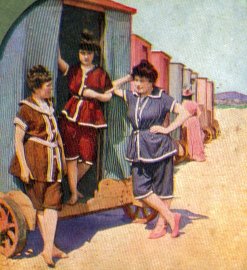Bathing machine
|
|
The bathing machine was a device which flourished in the 19th century to allow people to wade in the ocean at beaches without violating Victorian notions of modesty. Bathing machines were in the form of roofed and walled wooden carts which would be rolled into the sea. Some had solid wooden walls; others had canvas walls over a wooden frame.
The bathing machine was part of sea-bathing etiquette which was more rigorously enforced upon women than men, but was expected to be observed by people of both sexes among those who wished to be considered "proper".

Especially in Britain, men and women wishing to enjoy the sea were usually segregated into separate areas, so that nobody of the opposite sex might catch sight of them in their bathing suits, which (although extremely modest by more modern standards) were not considered proper clothing to be seen in by the general public.
| Contents |
Using a bathing machine
People would enter the small room of the bathing machine while it was on the dry beach, wearing their street-clothing. In the privacy of the machine they would then change into their bathing suit, placing their street clothes into a raised compartment where the clothing would remain dry.

The compartments of bathing machines had no windows, as their purpose was assurance of privacy. They were notoriously dark inside. A writer in the Manchester Guardian of May 26, 1906 wondered why bathing machines never had a glass skylight in the roof to allow in a bit of light. [1] (http://www.guardiancentury.co.uk/1899-1909/Story/0,6051,126381,00.html)
The bathing machine would then be wheeled or slid down into the ocean. The most common forms of bathing machines had large wide wheels and were propelled in and out of the surf by a horse or a pair of horses with a driver. Less common were bathing machines pushed in and out of the water by human power. Some very popular resorts had wooden rails put out into the water for the wheels to roll on; a few had their bathing machines pulled in and out by attached cables propelled by a steam engine.
Once in the water, the occupants would debark from the machine out the sea side down steps into the water. (Many bathing machines had doors at front and at back; those with only one door would either be backed down into the sea or need to be turned around in the trip.) It was considered essential that the water be entered in such a manner that the machine blocked any view of the bather from the shore. Some machines were equipped with a sort of canvas tent which could be lowered from the seaside door, sometimes capable of being lowered to the level of the water, giving the bather an area in the water with greater assurance of privacy.
Presumably some such bathing machine arrangements granted enough privacy that bathers could bathe nude, but if this was done it seems not to be generally mentioned in contemporary accounts.
Mention should be made of the practice at some resorts to employ a person called a "dipper". This would be a large strong person of the same sex as the bather who would assist the bather going into and out of the sea. Some dippers were said to rather roughly push the bathers into the water, then yank them out, but this was considered part of the ocean bathing experience.
BathingMachineDontBeAfraid.jpg
Bathing machines would often be equipped with a small flag which could be raised by the bather as a signal to the driver that they were ready to return to shore.
History of the bathing machine
According to some sources, the bathing machine was first developed about 1750 by one Benjamin Beale at the resort town of Margate, Kent. Other sources say they did not come into common use until some decades later. However, in the Scarborough Public Library there is an engraving by John Setterington dated 1736 which shows people bathing and appears to be the first recorded evidence for the use of bathing machines.
Bathing machines were most common in the United Kingdom and parts of the British Empire with a sizable British population, but were also used at beaches in France, Germany, the United States, and some other nations.
Legal segregation of bathing areas in Britain ended in 1901, and use of the bathing machine declined fairly rapidly thereafter. By the start of the 1920s bathing machines were almost extinct, even on beach resorts catering to an older clientele.
See also
External links
- Beale's bathing machine with canvas tent (http://www.margate-kent.freeserve.co.uk/bathing-machine.html)
- Martha Gunn (http://www.womenofbrighton.co.uk/marthagunn.htm) page about a professional dipper, with an illustration of a row of bathing machines employing dippers.de:Badekarre
